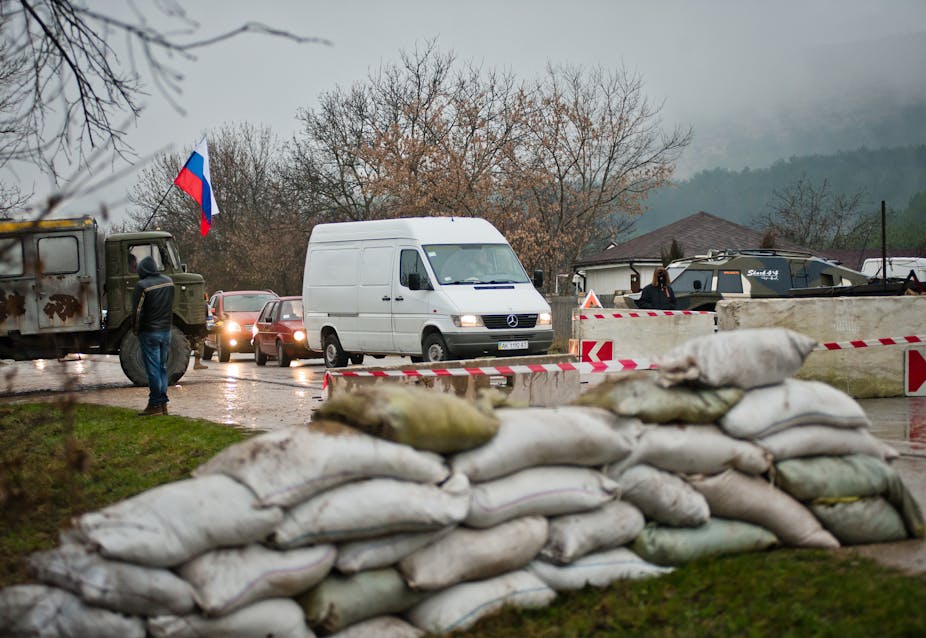These are dangerous times in Crimea. While the ongoing crisis in Ukraine has exposed the division between the country’s pro-Western and pro-Russian populations, another divide is more clear-cut and arguably more imminently threatening: the divide between supporters and opponents of separatism in Crimea.
This formerly Russian peninsula off the coast of southern Ukraine has seen clashes between these opposing camps, and reports suggest that government buildings and the regional parliament have been taken over by as yet unidentified armed men.
Separatist forces have a broad social base in Crimea. Available polling data since 2006 has consistently indicated that more than 50% of residents in the peninsula would support annexation to Russia. These figures suggest a strong pro-Russian sentiment among the region’s ethnic Russians and Russian-speaking Ukrainians, but not one that has so far automatically translated into an active pursuit of separatism.

At the same time, there are also strong anti-separatist forces in Crimea, notably the Crimean Tatars, who make up approximately 12% of the peninsula’s population. One of the Soviet Union’s nationalities that experienced deportation under Stalin, they have gradually returned to the Crimea since the break-up of the Soviet Union in 1991. While they have continued to experience ethnic prejudice and discrimination in Ukraine, they are, for obvious historical reasons, fundamentally opposed to Crimea “returning” to Russia.
Crimean autonomy
To date, these tensions between pro and anti-Russian forces, and between Tatars and non-Tatars, have been managed relatively well for two main reasons. First, Crimea has enjoyed a significant level of autonomy since the mid-1990s, the only region in Ukraine to do so, with its own locally elected legislature and government, allowing for an institutional and practical expression of the peninsula’s historical and cultural distinctiveness.
Stability in Crimea has also been in Russia’s interest. Working constructively with Ukraine in the immediate post-Soviet period to avoid a scenario similar to other so-called “frozen conflicts” in what Moscow considers its “near abroad”, most notably in Moldova (Transnistria) and Georgia (Abkhazia and South Ossetia), Russia has managed to retain a base for its Black Sea Fleet in Sevastopol.
Put differently, stability in Crimea is a function of stability in Kiev. A destabilisation in Ukrainian politics, as the country currently experiences it, creates local perceptions that put into question the status of Crimea as a self-governing region in Ukraine – and it causes alarm bells to ring in Moscow about the sustainability of its strategically most important naval base in the Black Sea.
While one may argue about how real or imagined these threats actually are, the confrontation between the different political camps in Crimea to which they have arguably given rise are very real. Given the broad reservoir of separatist sentiment into which local leaders can potentially tap, further rapid escalation is a very real possibility.
On alert
But a violent separatist conflict is by no means inevitable. While events in Crimea are clearly driven by developments in Kiev, the reaction – even among pro-Russian forces – has not been uniform. At the more radical end of the pro-Russian spectrum, politicians have asked for guarantees from Moscow, and Moscow appears to have obliged by putting some 150,000 troops on alert.
Other local politicians have adopted a more pragmatic stance, but one that is also not without risk of further confrontation with Kiev. They are considering the option of restoring the 1992 Constitution of Crimea. This established that Ukraine and Crimea formed a confederation and recognised “the Crimean people” and “the Crimean state”. The constitution also required Crimea’s consent for any change to its status proposed by the central government in Kiev.
While this is surely to be regarded with suspicion by Ukrainian nationalists, especially outside Crimea, it may be viewed as a stepping stone towards eventual independence and seen as encouraging similar demands in other regions, notably Donetsk and Luhansk.
It also offers an opportunity for de-escalation. A negotiation process may not necessarily end with a restoration of the 1992 Constitution, but at a minimum it could calm nerves in Simferopol and Moscow and decrease incentives there to inflame an already volatile situation further.
The apparent weakness of the Ukrainian state, which is particularly acute at the moment and arguably close to collapse, strengthens Crimea’s and Russia’s position in this bargaining situation. But, at the same time, it potentially undermines the sustainability of this very process and any result.
Political leaders in Simferopol and Moscow have to play their cards carefully and make sure that their actions do not further undermine the ability of elites in Kiev to maintain at least a minimally functioning government. Without a reasonably credible negotiating partner there, a break-up may yet become a self-fulfilling prophecy.
Given the local, regional and global political dynamics of the Ukrainian crisis, this is not going to be a “velvet divorce”, but could trigger the violence that Simferopol, Kiev, Moscow, Brussels and Washington should be keen to avoid.
Are you an academic in Ukraine at the moment? If so we are keen to hear from you: uk-editors@theconversation.com

